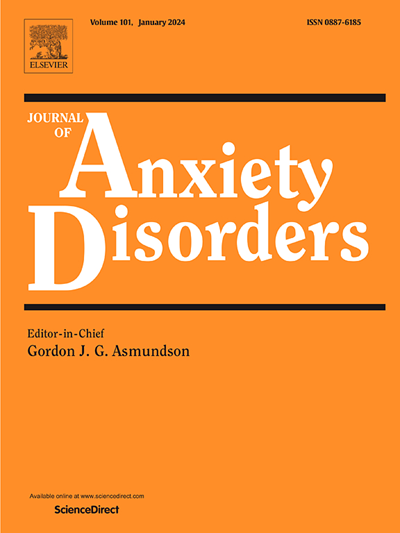Association of social and life threats with symptoms of posttraumatic stress disorder and social anxiety disorder
IF 4.5
2区 医学
Q1 PSYCHIATRY
引用次数: 0
Abstract
Background
This study examined psychological reactions to perceived threats, viewed within the context of human evolutionary history. We compared the relative weight of perceived threat to life or physical harm versus social threat, i.e., humiliation and/or rejection, in symptoms of posttraumatic stress disorder (PTSD) and social anxiety disorder (SAD).
Methods
Participants were 50 women with clinically significant posttraumatic stress symptoms (PTSS) and 59 women with little or no PTSS (control group) selected from a large, population-based cohort of women in Iceland, the SAGA Cohort. Participants rated (1) life threat, (2) physical threat, (3) humiliation, and (4) rejection during their worst trauma or stressor.
Results
Rates of both life and social threats were higher in the PTSS than control group. Among the PTSS participants, 4 % (n = 2) reported primarily life threats (vs. 6.8 %, n = 4 in controls), 36 % (n = 18) reported primarily social threats (vs. 33.9 %, n = 20 in controls), and 60 % (n = 30) reported both types of threats (vs. 15.3 %, n = 9 in controls). Those who reported dual life and social threats exhibited elevated PTSS compared to those who experienced a single type of threat. The highest levels of life or physical threat, along with humiliation, predicted PTSS severity, but rejection did not. Nearly half of the PTSS group (approximately 50 %, n = 25) also met criteria for SAD compared to roughly 14 % (n = 8) in the control group, and humiliation predicted SAD symptom severity. Notably, 18 % of the PTSS group (n = 9) linked the onset of their SAD and PTSS to a singular trauma or stressor involving a social threat.
Conclusions
The findings underscore the role of social threat in PTSD and SAD, with implications for theoretical models of both disorders.
社会和生命威胁与创伤后应激障碍和社交焦虑障碍症状的关系
本研究从人类进化史的角度考察了人们对感知到的威胁的心理反应。我们比较了在创伤后应激障碍(PTSD)和社交焦虑障碍(SAD)的症状中,对生命或身体伤害的感知威胁与社会威胁(即羞辱和/或拒绝)的相对权重。研究对象是50名有临床显著创伤后应激症状(PTSS)的女性和59名没有或很少有PTSS的女性(对照组),这些女性来自冰岛一个以人口为基础的大型女性队列SAGA队列。参与者在经历最严重的创伤或压力时对(1)生命威胁、(2)身体威胁、(3)羞辱和(4)拒绝进行评级。结果ptsd患者的生命威胁率和社会威胁率均高于对照组。分中参与者4 % (n = 2)报道主要生命威胁(和6.8 % n = 4控制),36 % (n = 18)报告主要社会威胁(和33.9 % n = 20控制),和60 % (n = 30)报道,这两种类型的威胁(与15.3 % n = 9控制)。那些报告双重生活和社会威胁的人比那些经历过单一类型威胁的人表现出更高的ptsd。生命或身体威胁的最高水平,以及羞辱,预示着ptsd的严重程度,但拒绝没有。近一半的PTSS组(约50 %,n = 25)也符合SAD标准,而对照组约14 % (n = 8),羞辱预测SAD症状的严重程度。值得注意的是,18% %的ptsd组(n = 9)将他们的SAD和ptsd的发病与涉及社会威胁的单一创伤或压力源联系起来。结论研究结果强调了社会威胁在PTSD和SAD中的作用,并对这两种疾病的理论模型具有启示意义。
本文章由计算机程序翻译,如有差异,请以英文原文为准。
求助全文
约1分钟内获得全文
求助全文
来源期刊

Journal of Anxiety Disorders
Multiple-
CiteScore
16.60
自引率
2.90%
发文量
95
期刊介绍:
The Journal of Anxiety Disorders is an interdisciplinary journal that publishes research papers on all aspects of anxiety disorders for individuals of all age groups, including children, adolescents, adults, and the elderly. Manuscripts that focus on disorders previously classified as anxiety disorders such as obsessive-compulsive disorder and posttraumatic stress disorder, as well as the new category of illness anxiety disorder, are also within the scope of the journal. The research areas of focus include traditional, behavioral, cognitive, and biological assessment; diagnosis and classification; psychosocial and psychopharmacological treatment; genetics; epidemiology; and prevention. The journal welcomes theoretical and review articles that significantly contribute to current knowledge in the field. It is abstracted and indexed in various databases such as Elsevier, BIOBASE, PubMed/Medline, PsycINFO, BIOSIS Citation Index, BRS Data, Current Contents - Social & Behavioral Sciences, Pascal Francis, Scopus, and Google Scholar.
 求助内容:
求助内容: 应助结果提醒方式:
应助结果提醒方式:


